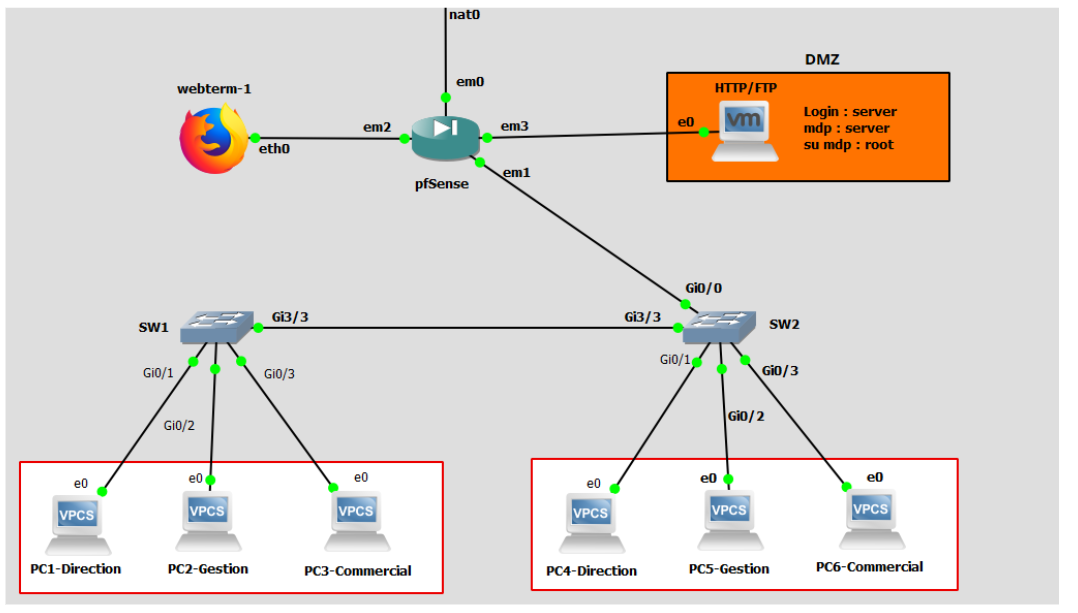SAE 2.01: Building an IT Network for a Small Business

In the field of Networks and Telecommunications, hands-on projects are crucial for bridging the gap between theoretical knowledge and real-world application. During my studies, I undertook the SAE 2.01: Building an IT Network for a Small Business project. This initiative focused on deploying a comprehensive network infrastructure for a small company using the simulation software GNS3. The primary objective was to design a network topology that effectively supports essential services such as HTTP and FTP, ensuring seamless communication and data management within the organization.
Project Overview
The SAE 2.01 project aimed to develop a functional IT network tailored to the needs of a small business. By leveraging GNS3 (Graphical Network Simulator-3), a powerful network simulation tool, we were able to design, test, and refine the network setup in a virtual environment before any actual deployment. This approach provided a risk-free platform to experiment with configurations and troubleshoot potential issues, ensuring a robust and reliable network upon implementation.
Objectives
- Network Deployment: Establish a scalable and secure network infrastructure that meets the operational requirements of a small business.
- Service Integration: Ensure the seamless integration of essential services, specifically HTTP for web services and FTP for file transfers.
- Performance Optimization: Design a network topology that enhances performance, minimizes latency, and ensures efficient data flow.
- Security Implementation: Incorporate security measures to protect the network from unauthorized access and potential threats.
- Simulation and Testing: Utilize GNS3 to simulate the network environment, allowing for extensive testing and optimization before real-world deployment.
Tasks and Responsibilities
1. Network Design and Planning
The initial phase involved understanding the business requirements and designing an appropriate network topology. We began by assessing the number of users, types of devices, required services, and security needs. Based on this assessment, we developed a network diagram outlining the placement of routers, switches, servers, and other critical components.
2. Simulation with GNS3
Using GNS3, we created a virtual representation of the proposed network. This simulation enabled us to:
- Configure Network Devices: Set up routers and switches with appropriate settings, including IP addressing, routing protocols, and VLAN configurations.
- Implement Services: Deploy HTTP and FTP services on designated servers, ensuring they were accessible and secure.
- Test Connectivity: Verify communication between devices within the network, ensuring that data flows seamlessly and services are operational.
- Identify and Resolve Issues: Detect potential bottlenecks, security vulnerabilities, and configuration errors in the virtual environment before actual deployment.
3. Service Integration
HTTP Service
We set up an HTTP server to handle web services, allowing employees and clients to access the company's website and internal web applications. This involved configuring web server software (such as Apache or Nginx), setting up virtual hosts, and ensuring secure access through HTTPS protocols.
FTP Service
An FTP server was deployed to facilitate secure file transfers within the organization. This setup included configuring FTP server software (such as vsftpd or FileZilla), managing user permissions, and implementing security measures like SSL/TLS encryption to protect data during transmission.
4. Security Implementation
Ensuring the security of the network was paramount. We implemented several security measures, including:
- Firewall Configuration: Set up firewalls to monitor and control incoming and outgoing traffic based on predefined security rules.
- Access Control: Defined access control lists (ACLs) to restrict unauthorized access to sensitive network segments and services.
- Encryption: Enabled encryption protocols for HTTP and FTP services to protect data integrity and confidentiality.
- Regular Updates and Patching: Ensured that all network devices and services were regularly updated to protect against known vulnerabilities.
5. Performance Optimization
To enhance network performance, we optimized configurations by:
- VLAN Segmentation: Segmented the network into VLANs to reduce broadcast domains, minimize congestion, and improve overall efficiency.
- Quality of Service (QoS): Implemented QoS policies to prioritize critical traffic, ensuring that essential services like HTTP and FTP received the necessary bandwidth.
- Load Balancing: Configured load balancing mechanisms to distribute network traffic evenly across multiple paths, enhancing reliability and preventing single points of failure.
6. Documentation and Training
Comprehensive documentation was created to detail the network setup, configurations, and operational procedures. Additionally, training sessions were conducted for the company's IT staff to ensure they were equipped to manage and troubleshoot the new infrastructure effectively.
Skills Developed
- Network Simulation and Design: Enhanced my ability to design and simulate complex network architectures using advanced tools like GNS3.
- Service Configuration: Gained hands-on experience in setting up and securing HTTP and FTP services, ensuring they operate efficiently and safely.
- Security Best Practices: Developed a strong understanding of network security principles, including firewall configuration, access control, and encryption.
- Problem-Solving: Improved my troubleshooting skills by identifying and resolving issues within the simulated network environment.
- Project Management: Learned to manage a project from planning and design to implementation and documentation, ensuring timely and effective completion.
Conclusion
The SAE 2.01: Building an IT Network for a Small Business project was a significant learning experience that allowed me to apply theoretical knowledge in a practical setting. By utilizing GNS3 for network simulation, I was able to design, test, and optimize a reliable and secure network infrastructure tailored to the needs of a small business. This project not only enhanced my technical skills in network design and service configuration but also underscored the importance of meticulous planning and proactive problem-solving in successful IT deployments.
This hands-on project serves as a valuable addition to my professional portfolio, showcasing my capability to design and implement effective IT solutions that meet the operational and security needs of businesses. It demonstrates my expertise in creating scalable, efficient, and secure network infrastructures, positioning me well for future challenges in the field of cybersecurity and network management.
